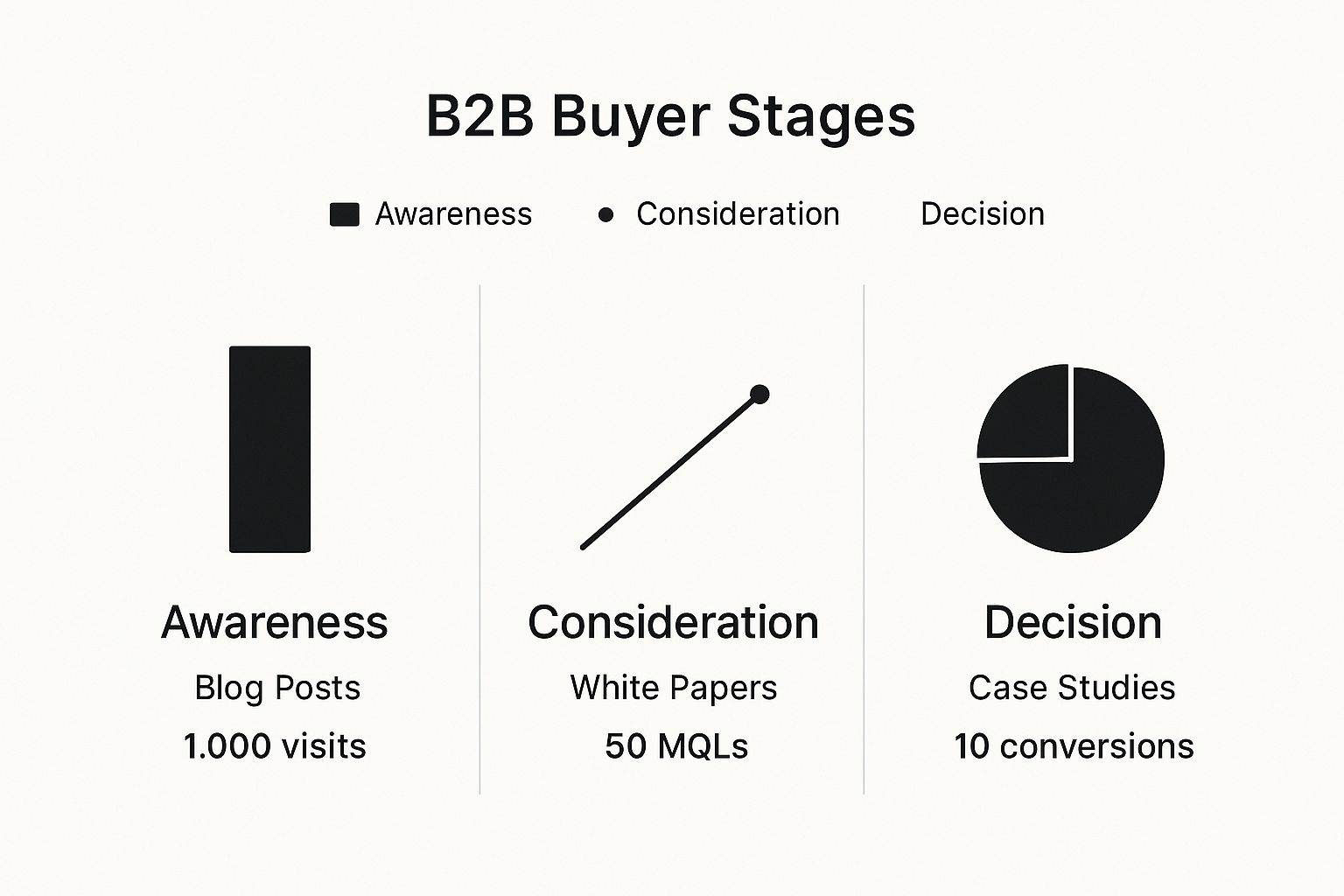Let's be honest, the old way of selling to other businesses is dead. B2B content marketing isn't just about writing blog posts; it's about fundamentally changing the conversation. Instead of a hard pitch, you're offering real value and solving problems for your ideal customers before they even think about buying.
This is how you build trust and become the go-to authority in your space. Ultimately, it’s the engine that drives leads, nurtures those critical relationships, and gets you profitable new business.
Why B2B Content Marketing Is Your Growth Engine

Forget the textbook definitions for a minute. Think of content marketing as shifting your role from a cold-calling salesperson to the industry’s most trusted advisor. You’re starting a conversation and providing value long before a purchase is ever on the table. That credibility pays off in a big way when it’s finally time for them to make a decision.
Why is this so critical now? Because the B2B buyer has completely changed. They’re self-starters. They do their own deep-dive research and are experts at tuning out the traditional, interruptive sales pitch. A huge chunk of their buying journey happens on their own, fueled by the digital resources they can find.
Meeting Buyers Where They Are
A smart content strategy doesn't chase buyers; it meets them right where they are—on Google, on LinkedIn, and in industry forums. By creating content that answers the exact questions they're asking, you organically insert your brand into their research phase.
This is how you build real authority. The dynamic flips completely. Instead of you finding them, they find you.
"Your content becomes the silent salesperson working 24/7. It educates, nurtures, and qualifies leads, ensuring that when a prospect finally reaches out, they are already convinced of your expertise and value."
This isn't some optional tactic anymore. It's the core of sustainable growth, guiding prospects through every single stage of their journey. To really dig into how this works, checking out a modern sales funnel B2B guide will help you visualize the path from stranger to customer.
The True Impact on Business Growth
The payoff for a solid B2B content strategy goes way beyond just brand awareness. It directly hits your bottom line by creating a predictable, scalable pipeline of high-quality leads.
Here’s how it fuels your growth:
- Generates Compounding ROI: A single great blog post can pull in leads for years. That’s a stark contrast to a paid ad, which stops working the second you stop paying for it. Your content’s value actually grows over time.
- Shortens the Sales Cycle: Educated prospects make decisions faster. Period. By addressing their questions and objections upfront, your content warms them up before they ever even talk to a sales rep.
- Lowers Customer Acquisition Costs (CAC): Organic traffic is simply more cost-effective than relying on paid channels alone. A strong content library eventually reduces your dependency on ad spend, saving you serious money.
Building Your B2B Audience and Content Roadmap
Great content aimed at the wrong people is like a brilliant speech delivered to an empty room—a total waste of effort. Real success in content marketing for b2b starts with a roadmap that clearly defines who you're talking to and what you want to achieve with every single piece you publish.
This goes way beyond basic demographics. It's about building a detailed Ideal Customer Profile (ICP), which is essentially a fictional sketch of your perfect customer organization. Think of it as a blueprint for the type of company that gets the most value from your solution and, in turn, provides the most value to your business.
Defining Your Ideal Customer Profile
A strong ICP isn't just about company size or industry. It digs into the real business context—their professional pain points, their operational headaches, and their ambitious growth goals. To build a solid ICP, you need to answer a few key questions:
- Firmographics: What's their industry, annual revenue, and employee count?
- Pain Points: What specific problems keep their leadership team up at night? Are they bogged down by inefficiency, high costs, or intense competitive pressure?
- Business Goals: What are they trying to accomplish? Maybe it's expanding into new markets, improving customer retention, or finally adopting new technology.
- Buying Triggers: What events usually kick off their search for a solution like yours?
Once you’ve nailed down your ICP, you can get even more specific by creating buyer personas for the key decision-makers inside those companies. This helps you tailor content to the CFO who only cares about ROI, the IT Manager obsessed with integration, and the end-user who just wants a smoother daily workflow.
Set SMART Goals for Real Business Outcomes
A roadmap needs a destination. Without clear goals, your content efforts will feel random and you'll have no way to measure what's working. This is where the SMART framework comes in—it forces you to set objectives that are Specific, Measurable, Achievable, Relevant, and Time-bound.
Ditch vague targets like "increase brand awareness." Instead, set a goal like: "Generate 150 new marketing qualified leads (MQLs) from our blog in Q3 by targeting keywords related to SaaS project management." An approach like this ties your content directly to a business outcome.
The B2B buying game has changed. Buyers do most of their research on their own, long before they ever talk to sales, and they expect content that speaks directly to their needs. This shift has pushed marketers to get more strategic. As of 2024, more than half of B2B marketers worldwide now have a documented content strategy, a huge jump from just a few years ago. You can find more on this and other B2B marketing insights on npws.net.
Mapping Content to the Buyer’s Journey
Different types of content do different jobs at each stage of the buyer's journey. By mapping your content, you can guide prospects from that first spark of curiosity all the way to a final purchase decision.
A documented content strategy is your North Star. It ensures every blog post, white paper, and case study has a clear purpose, a specific audience, and a measurable goal. It’s the difference between a plan and just random acts of content.
This infographic breaks down how different content formats can deliver results at each stage.

As you can see, broader top-of-funnel content like blog posts is great for driving initial traffic. But to convert that interest into qualified leads and sales, you need more in-depth assets like white papers and case studies.
Choosing the Right B2B Content Formats

Your content arsenal is so much more than just blog posts. Think of different content formats as tools in a workshop—you wouldn't grab a hammer when you need a screwdriver. The best content marketing for b2b works the same way. It's all about picking the right format for the right job.
A killer case study can deliver the social proof needed to nudge a prospect over the finish line. A deep-dive white paper, on the other hand, cements your authority on a tough subject. Each format has a specific job to do.
Aligning Formats with Your Goals
Before you create anything, you need to know why you're creating it. Are you trying to get on the radar of someone who's just realizing they have a problem? Or are you trying to win over a buyer who is actively weighing their options? Each goal requires a completely different playbook.
- For Awareness: Blog posts, infographics, and quick videos are perfect for grabbing attention at the top of the funnel. They're easy to digest, highly shareable, and great for SEO.
- For Consideration: This is where you go deeper. Think white papers, e-books, and webinars that offer serious value in exchange for lead information.
- For Decision: Case studies, live demos, and head-to-head comparison guides give buyers the hard facts and proof they need to sign on the dotted line.
Feeling stuck on what to even write about? Our guide on fresh content generation ideas can help kickstart your brainstorming.
The Power of Long-Form Content in B2B
Short-form content absolutely has its place, but in B2B, the heavy lifting is done by long-form assets. Think ultimate guides, in-depth reports, and cornerstone articles. These pieces are SEO gold because they deliver the comprehensive answers that both Google and serious business buyers are looking for.
It's no surprise that a staggering 83% of B2B marketers are focused on using content to build brand awareness. And depth matters—the average top-ranking Google result for B2B keywords is around 1,447 words long. This just proves how much value there is in going deep. In fact, the demand for quality is so high that 84% of B2B marketers now outsource content creation to get it right.
Deep, authoritative content does two things brilliantly: it signals to Google that you're an expert, and it proves it to your prospects. It builds trust and becomes a pillar asset you can chop up into dozens of smaller pieces for social media, emails, and more.
Engaging Buyers with Interactive and Visual Formats
Let's be honest, a wall of text can make even the most interested professional's eyes glaze over. This is where interactive and visual formats come in to save the day, offering a much more engaging way to get your point across.
Webinars are a prime example. They create a direct, real-time connection with your audience through live Q&A sessions and position your team as accessible experts. Videos are another powerhouse, breaking down complex ideas into something digestible and memorable.
Choosing the Right B2B Content Format
To help you map this all out, here’s a straightforward table breaking down the most common B2B formats, what they’re best for, and what it’ll take to produce them.
The secret is to strategically mix and match these formats. A smart content plan meets your audience at every single touchpoint, guiding them from their first Google search all the way to becoming a customer. The key is to be intentional, tying every single piece of content back to a clear business goal and a specific audience need.
How to Measure Your B2B Content Marketing ROI
Throwing great content out into the world is one thing. Proving it actually drives business is another game entirely. If you want to move your content program from a "nice-to-have" expense to a proven revenue engine, you have to measure its return on investment (ROI).
This means looking past the easy-to-track vanity metrics like page views or social media likes. Sure, they show you’re getting eyeballs, but they don’t tell your CFO what they really need to know: how is this content actually helping us make money? The goal is to build a rock-solid business case that doesn’t just justify your budget but demands a bigger one.
Moving Beyond Vanity Metrics
The first step is to know the difference between top-of-funnel metrics (building awareness) and bottom-of-funnel metrics (driving sales). Both matter, but they tell different parts of your story.
- Top-of-Funnel (Awareness): Think organic traffic, keyword rankings, and backlinks. These numbers show that your content is successfully pulling in a new audience and cementing your brand's authority in search results. You're getting found.
- Middle-of-Funnel (Consideration): Now we’re tracking engagement. Key signs of life here include conversion rates on landing pages (like an ebook download), time on page, and the number of marketing qualified leads (MQLs) your content generates.
- Bottom-of-Funnel (Decision): This is where content meets cash. You're measuring sales qualified leads (SQLs), customer acquisition cost (CAC), and the holy grail—sales pipeline influenced by content.
Let's be real: you can't track this stuff with just a spreadsheet. You need a solid tech stack—analytics tools to see what people do on your site, marketing automation to capture leads, and a CRM to connect those leads to actual deals. Without this plumbing in place, proving ROI is a shot in the dark.
Connecting Content to Revenue
So, how do you prove that the white paper someone downloaded three months ago helped close a six-figure deal today? That’s where attribution models come in. An attribution model is just a set of rules that decides how to give credit to the different touchpoints a customer interacts with on their way to buying.
For example, a first-touch attribution model gives 100% of the credit to the first thing a prospect saw, like a blog post they found on Google. A last-touch model gives all the credit to the final piece they viewed, like a case study they read right before asking for a demo. Of course, more sophisticated multi-touch models spread the credit across multiple interactions.
The key is to pick a model that actually makes sense for your sales cycle and then stick with it. Consistency is what allows you to show how different types of content contribute value at every stage, from that first "hello" to the final signed contract.
And the data backs this up. Recent stats show 83% of marketers hit their brand awareness goals with content, and 77% built more trust and credibility with their buyers. This isn't fluff; it’s a core part of how modern B2B companies win.
Ultimately, building a powerful business case is what gets you the resources to scale. For a no-nonsense guide on this, check out this post on how to measure content marketing ROI the right way. And to go even deeper, our complete guide covers all the essential content marketing metrics you should be tracking.
Scaling Your Content with Budgets and Technology

A brilliant content strategy is only as good as its execution. To bring your ideas to life and actually get results, you need to nail the practical side of things—your budget and your tech stack. This is where you build the operational engine that turns plans into measurable growth.
Investing in content marketing for B2B isn't just about paying writers and designers. A truly successful program treats content promotion and distribution as necessities, not afterthoughts. Creating an amazing asset is only half the battle; making sure it reaches the right people is the other half.
Smart Budget Allocation for B2B Content
Think of your content budget as a three-legged stool: creation, promotion, and technology. If one leg is too short, the whole thing wobbles. Too many companies pour their resources into creation and then wonder why their beautifully designed white paper is collecting digital dust.
Here’s a practical way to split your funds:
- Content Creation (40-50%): This is the core of your program, covering the costs of producing your assets—from writing and design to video production.
- Promotion & Distribution (30-40%): This is your budget for getting eyeballs on your content. It includes paid social campaigns, search ads, email marketing, and influencer collaborations.
- Technology & Tools (10-20%): This is your investment in the software that makes everything run smoothly, from analytics platforms to marketing automation systems.
This balanced approach ensures you not only create high-quality content but also have the firepower to amplify its reach and impact. You're building a system, not just a library of assets.
The trend is clear: by 2025, more than half (54%) of businesses plan to increase their content marketing spend. B2B firms are already dedicating about 33% of their total marketing budget to content, and crucially, 67% of these companies are investing in promotion beyond just creation. To see more on how businesses are getting the most out of their spend, you can find additional B2B content marketing statistics on thecmo.com.
Leveraging Technology for Efficiency and ROI
Technology is the force multiplier for your content strategy. The right tools don't just save you time; they unlock new capabilities that would be impossible to manage manually, especially as you scale. They help you operate more efficiently, nurture leads at scale, and measure your return with far greater precision.
"Marketing technology transforms your content program from a series of manual tasks into an automated, scalable engine. It’s the difference between rowing a boat and captaining a speedboat."
This is especially true in B2B, where sales cycles are long and require multiple touchpoints. The right tech helps you stay top-of-mind throughout that entire journey.
Key Technologies for a Modern B2B Content Program
To build a robust and scalable content engine, certain technologies are non-negotiable. They provide the infrastructure needed to connect your content efforts directly to business outcomes.
Here are the essential tools to consider:
- Marketing Automation Platforms: Think of these as the central nervous system for your lead nurturing. They let you create automated email sequences triggered by user behavior, like downloading a white paper, ensuring timely and relevant follow-ups without any manual effort.
- Customer Relationship Management (CRM): A CRM is vital for connecting the dots between marketing activities and sales results. It tracks every interaction a lead has with your content, giving your sales team valuable context and helping you prove how content influenced closed deals.
- Analytics and SEO Tools: Platforms like Google Analytics, paired with SEO tools, give you deep insights into content performance. They help you understand which topics resonate, how users find your content, and where to double down on your efforts.
- Generative AI Tools: The newest addition to the stack, generative AI can seriously boost team productivity. It can help brainstorm ideas, draft initial outlines, and even repurpose a long-form blog post into a dozen social media snippets, freeing up your team for more strategic work.
The Future of B2B Content: AI and Personalization Are Here
If you look at the B2B content landscape today, two massive shifts are already underway: the rise of AI and the demand for true personalization. These aren't just buzzwords for a 2025 roadmap; they're actively separating the brands that win from those that get ignored.
The game is no longer about churning out more blog posts or more whitepapers. It’s about creating smarter, more relevant experiences that feel like they were made for an audience of one.
AI Is Your New Strategic Partner
Let's get one thing straight: AI isn't here to replace good marketers. It's here to supercharge them. Think of it less like a robot writer and more like a data-crunching analyst that never sleeps.
AI does the heavy lifting, sifting through mountains of data to find patterns and opportunities that a human team could easily miss. This frees up your marketers to focus on what they do best: crafting compelling stories and building relationships. The sharpest B2B teams are already using it to get an edge.
Here’s how they’re putting it to work:
- Uncovering Hidden Audience Insights: AI tools can tear through customer data, social media chatter, and market reports to build buyer personas so detailed they feel like real people. You'll spot pain points you never knew existed.
- Making SEO a Science: Instead of guessing, modern AI can actually forecast the traffic potential of certain keywords and topics. This lets you stop wasting resources and double down on content that’s guaranteed to deliver.
- Fine-Tuning Every Single Asset: From suggesting the perfect internal link to making sure your tone of voice is perfectly on-brand, AI acts as a final quality check before anything goes live.
To get a real sense of what's possible, it’s worth exploring the best AI marketing tools available today and seeing how they could plug into your existing workflow.
Hyper-Personalization Is the New Standard
The next evolution is hyper-personalization, and it’s a world away from dropping {{first_name}} into an email.
This is about dynamic, real-time content that changes based on a user's behavior, their industry, their job title, or even the last three pages they visited on your website.
Imagine a pricing page that automatically reorders features to highlight what’s most important to a visitor from the healthcare industry. Or a blog post that serves up different case studies depending on whether the reader is from a startup or an enterprise. That’s the level of customization that makes a prospect feel seen and understood, which is a huge step toward earning their trust.
Hyper-personalization is the difference between shouting a message from a generic billboard and having a personal guide whisper the right answer at the right time. It builds trust by anticipating a buyer's needs before they even have to ask.
This isn't just a "nice-to-have" anymore. Top-performing B2B brands are pouring their budgets into integrating AI, personalization, and interactive content to meet these new buyer expectations. This shift is especially clear in competitive markets like North America and Western Europe, where you have to constantly innovate to stand out. Embracing these changes is how you shorten the sales cycle.
Interactive Content: The Ultimate Data-Gathering Tool
Finally, don't sleep on interactive content like ROI calculators, assessments, and quizzes. These tools are absolute goldmines.
Why? Because they do more than just keep a visitor engaged. They turn a passive reader into an active participant. In exchange for a personalized report or a helpful calculation, prospects will gladly tell you their biggest challenges, their goals, and their current tech stack.
This isn't just data; it's high-quality, first-party insight that you can use to fuel your entire personalization engine. It creates a powerful feedback loop where every interaction makes your marketing smarter and more effective.
B2B Content Marketing FAQs
You’ve got questions, we’ve got answers. When you're in the trenches with B2B content marketing, a few key questions always seem to pop up. Let's tackle them head-on.
How Long Until I See Results from B2B Content Marketing?
This is the big one. Unlike a paid ad campaign that gives you a quick (but temporary) hit, content marketing is all about building an asset that pays dividends over time. It’s a long game.
You'll likely see early glimmers of hope—like a nice bump in organic traffic—within 3-6 months. But for the real prize, like a steady stream of qualified leads knocking on your door, you need to give it 6-12 months.
Think of it like planting an orchard. You don't get apples the day after you plant a seed. It takes consistent watering and patience. But once those roots take hold, you get a reliable harvest year after year. The goal here is sustainable growth, not a one-off spike.
How Much Should a B2B Company Budget for Content Marketing?
There’s no magic number, but a solid starting point is dedicating 25-35% of your total marketing budget to your content efforts. That budget needs to cover three things: creating the content, promoting it, and the tech stack you use to manage it all.
The rookie mistake? Spending everything on creation and leaving nothing for promotion. A good rule of thumb is to spend just as much getting your content in front of people as you did making it.
An incredible piece of content that nobody sees has an ROI of exactly zero. Creation is only half the job; you have to budget for getting it seen.
Can a Small Team Still Succeed with B2B Content Marketing?
Absolutely. In fact, a small, focused team can often run circles around a big, bloated one. Success isn't about headcount; it's about strategy.
Here’s how a small team can punch way above its weight:
- Own a Niche: Don't try to be everything to everyone. Pick one specific area where your ideal customer has a ton of pain and become the undisputed expert on that single topic.
- Go for Quality, Not Quantity: One killer, in-depth guide is worth more than ten flimsy blog posts. Focus your energy on creating one truly exceptional asset.
- Repurpose Everything: That one webinar you hosted? It can be chopped into multiple blog posts, a dozen social media clips, an infographic, and a handful of shareable quotes. Squeeze every last drop of value out of what you create.
It’s all about working smarter. A lean team that masters a niche and gets maximum mileage from every single piece of content can make a massive impact.
Ready to make your SaaS brand an authority in your niche? PimpMySaaS helps B2B SaaS companies dominate conversations on Reddit, getting your brand cited in AI responses and seen by your ideal customers. Learn how we can elevate your online presence at https://www.pimpmysaas.com.
